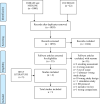Structured approach with primary and secondary survey for major trauma care: an overview of reviews
- PMID: 36600301
- PMCID: PMC9814503
- DOI: 10.1186/s13017-022-00472-6
Structured approach with primary and secondary survey for major trauma care: an overview of reviews
Abstract
Background: A structured approach involves systematic management of trauma patients. We aim to conduct an overview of reviews about the clinical efficacy and safety of structured approach (i.e., primary and secondary survey) by guideline checklist compared to non-structured approach (i.e. clinical examination); moreover, routine screening whole-body computer tomography (WBCT) was compared to non-routine WBCT in patients with suspected major trauma.
Methods: We systematically searched MEDLINE (PubMed), EMBASE and Cochrane Database of Systematic Reviews up to 3 May 2022. Systematic reviews (SRs) that investigated the use of a structured approach compared to a non-structured approach were eligible. Two authors independently extracted data, managed the overlapping of primary studies belonging to the included SRs and calculated the corrected covered area (CCA). The certainty of evidence was assessed using the Grading of Recommendations Assessment, Development and Evaluation (GRADE) methodology.
Results: We included nine SRs investigating two comparisons in stable trauma patients: structured approach vs non-structured approach (n = 1) and routine WBCT vs non-routine WBCT (n = 8). The overlap of included primary studies was generally high across outcomes (CCA ranged between 20.85 and 42.86%) with some discrepancies in the directions of effects across reviews. The application of a structured approach by checklist may improve adherence to guidelines (e.g. Advanced Trauma Life Support) during resuscitation and might lead to a reduction in mortality among severely injured patients as compared to clinical examination (Adjusted OR 0.51; 95% CI 0.30-0.89; p = 0.018; low certainty of evidence). The use of routine WBCT seems to offer little to no effects in reducing mortality and time spent in emergency room or department, whereas non-routine WBCT seems to offer little to no effects in reducing radiation dose, intensive care unit length of stay (LOS) and hospital LOS (low-to-moderate certainty of evidence).
Conclusions: The application of structured approach by checklist during trauma resuscitation may improve patient- and process-related outcomes. Including non-routine WBCT seems to offer the best trade-offs between benefits and harm. Clinicians should consider these findings in the light of their clinical context, the volume of patients in their facilities, the need for time management, and costs.
Keywords: Advanced trauma life support care; Checklist; Diagnostic imaging; Emergency medicine; GRADE approach; Meta-analysis as topic; Structured approach; Systematic reviews.
© 2023. The Author(s).
Conflict of interest statement
The authors declare that they have no competing interests.
Figures
References
-
- Aldridge E, Sethi D, Yon Y. Injuries: a call for public health action in Europe: an update using the 2015 WHO global health estimates. Copenhagen: World Health Organization. Regional Office for Europe; 2017. p. 2017.
-
- Committee on Diagnostic Error in Health Care; Board on Health Care Services; Institute of Medicine; The National Academies of Sciences, Engineering, and Medicine; Balogh EP, Miller BT, Ball JR, editors. Improving Diagnosis in Health Care. Washington (DC): National Academies Press (US); 2015 Dec 29. 2, The Diagnostic Process. Available from: https://www.ncbi.nlm.nih.gov/books/NBK338593/. - PubMed





